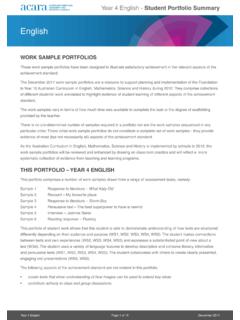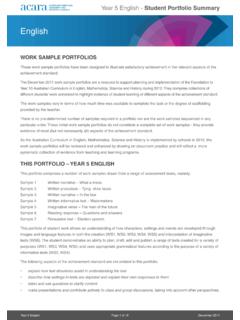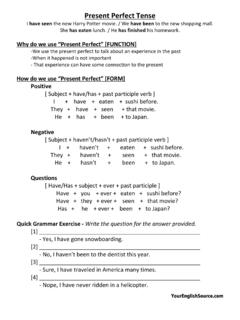Transcription of English - ACARA
1 Year 2 English December 2011 Page 1 of 17 EnglishYear 2 English - Student Portfolio SummaryWORK SAMPLE PORTFOLIOST hese work sample portfolios have been designed to illustrate satisfactory achievement in the relevant aspects of the achievement December 2011 work sample portfolios are a resource to support planning and implementation of the Foundation to Year 10 Australian Curriculum in English , Mathematics, Science and History during 2012. They comprise collections of different students work annotated to highlight evidence of student learning of different aspects of the achievement work samples vary in terms of how much time was available to complete the task or the degree of scaffolding provided by the teacher.
2 There is no pre-determined number of samples required in a portfolio nor are the work samples sequenced in any particular order. These initial work sample portfolios do not constitute a complete set of work samples - they provide evidence of most (but not necessarily all) aspects of the achievement standard. As the Australian Curriculum in English , Mathematics, Science and History is implemented by schools in 2012, the work sample portfolios will be reviewed and enhanced by drawing on classroom practice and will reflect a more systematic collection of evidence from teaching and learning programs. THIS PORTFOLIO YEAR 2 ENGLISHThis portfolio comprises a number of work samples drawn from a range of assessment tasks, namely: Sample 1 Instruction text Yummy fruit sticks Sample 2 Response to literature Carla s Crocodile Adventures Sample 3 Factual report Wombats Sample 4 Response to literature Tough Boris Sample 5 Imaginative text The mad story about a pirate Sample 6 Group discussion Creating a fairy taleThis portfolio of student work shows an understanding that different types of texts serve different purposes and an ability to identify different text structures and language features (WS1, WS3).
3 The student uses a variety of text processing strategies to read, (WS5), retrieve literal information (WS4, WS5), make inferences (WS4) and find the main idea in a text (WS4). The student creates written and multimodal texts for specific purposes and audiences (WS1, WS2, WS3, WS4, WS5) drawing on knowledge of grammar, vocabulary and punctuation. (WS1, WS2, WS3, WS4, WS5). They portfolio demonstrates the ability to spell most high-frequency sight words and to use sound-letter knowledge to attempt new words (WS1, WS2, WS3, WS4, WS5).The following aspects of the achievement standard are not evident in this portfolio: understand how similar texts share characteristics by identifying text structures make connections between texts by comparing content listen for particular purposes and manipulate sound combinations and rhythmic sound patterns discuss ideas and experiences explain preferences for aspects of texts using other texts as comparisons engage in group and class discussions and make 2 English December 2011 Page 2 of 17 Year 2 English - Work sample 1 EnglishWork sample 1.
4 Instruction text Yummy fruit sticksRelevant parts of the achievement standardReceptive modes (listening, reading and viewing)By the end of Year 2, students understand how similar texts share characteristics by identifying text structures and language features used to describe characters, settings and events. They read texts that contain varied sentence structures, some unfamiliar vocabulary, a significant number of high frequency sight words and images that provide additional information. They monitor meaning and self-correct using context, prior knowledge, punctuation, language and phonic knowledge. They identify literal and implied meaning, main ideas and supporting detail.
5 Students make connections between texts by comparing content. They listen for particular purposes. They listen for and manipulate sound combinations and rhythmic sound modes (speaking, writing and creating)When discussing their ideas and experiences, students use everyday language features and topic-specific vocabulary. They explain their preferences for aspects of texts using other texts as comparisons. They create texts that show how images support the meaning of the create texts, drawing on their own experiences, their imagination and information they have learned. They use a variety of strategies to engage in group and class discussions and make presentations. They accurately spell familiar words and attempt to spell less familiar words and use punctuation accurately.
6 They legibly write unjoined upper- and lower-case of taskThis tast had two components:1. Students were asked to write a text to instruct someone on how to make fruit sticks. The structure of the type of text was modelled and explained and a planning worksheet was provided for the first drafts of The students were asked to use the first draft to create a multimodal digital text. The teacher worked with the student to create the second draft. In the second draft the red font denotes the teacher s 2 English December 2011 Page 3 of 17 EnglishYear 2 English - Work sample 1 AnnotationsUses headings to write legibly using unjoined lower- and upper-case known irregular words correctly, for example put , you , and corrects new words for final publication, for example chopping.
7 Work sample 1: Instruction text Yummy fruit sticksYear 2 English December 2011 Page 4 of 17 EnglishAcknowledgmentACARA acknowledges the contribution of the trial school teachers and students for providing the tasks and work samples. The annotations are referenced to the Australian Curriculum achievement 2 English - Work sample 1 AnnotationsUses well-chosen images to support the meaning of the familiar and some new topic specific vocabulary, for example peel , fruit , skewer .Writes simple sentences with command verbs to provide clear instructions, for example Cut the fruit and compound sentences to connect ideas, for example Melt the chocolate and put it into the bowl.
8 Uses language resources to assist text cohesion, for example pronouns . Produces edited text with attention to spelling and sample 1: Instruction text Yummy fruit sticksAnnotations (Overview)This work sample demonstrates the creation of a multimodal informative text designed to provide instructions for completing a process. The text demonstrates understanding of text features including layout, use of fonts and inclusion of images. The worksheet and the final text demonstrate the writing process undertaken by the student, with teacher assistance, from planning to published 2 English December 2011 Page 5 of 17 EnglishYear 2 English - Work sample 2 Work sample 2: Response to literature Carla s Crocodile AdventuresRelevant parts of the achievement standardReceptive modes (listening, reading and viewing)By the end of Year 2, students understand how similar texts share characteristics by identifying text structures and language features used to describe characters, settings and events.
9 They read texts that contain varied sentence structures, some unfamiliar vocabulary, a significant number of high frequency sight words and images that provide additional information. They monitor meaning and self-correct using context, prior knowledge, punctuation, language and phonic knowledge. They identify literal and implied meaning, main ideas and supporting detail. Students make connections between texts by comparing content. They listen for particular purposes. They listen for and manipulate sound combinations and rhythmic sound modes (speaking, writing and creating)When discussing their ideas and experiences, students use everyday language features and topic-specific vocabulary.
10 They explain their preferences for aspects of texts using other texts as comparisons. They create texts that show how images support the meaning of the create texts, drawing on their own experiences, their imagination and information they have learned. They use a variety of strategies to engage in group and class discussions and make presentations. They accurately spell familiar words and attempt to spell less familiar words and use punctuation accurately. They legibly write unjoined upper- and lower-case of taskStudents were asked to read a story of their choice and then to retell the story in sequenced images and accompanying 2 English December 2011 Page 6 of 17 EnglishAcknowledgmentACARA acknowledges the contribution of the trial school teachers and students for providing the tasks and work samples.








